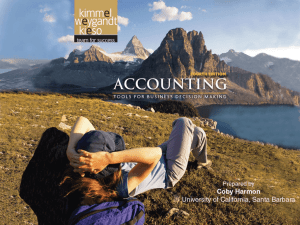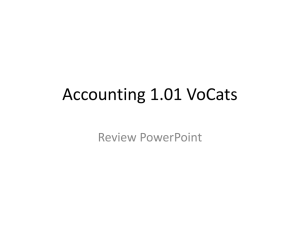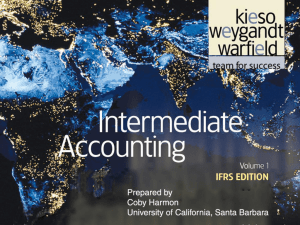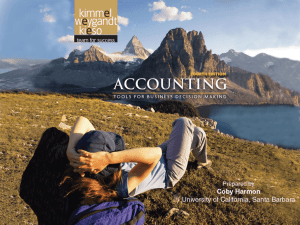Chp 2 Slides 02_Ch_2_Slides
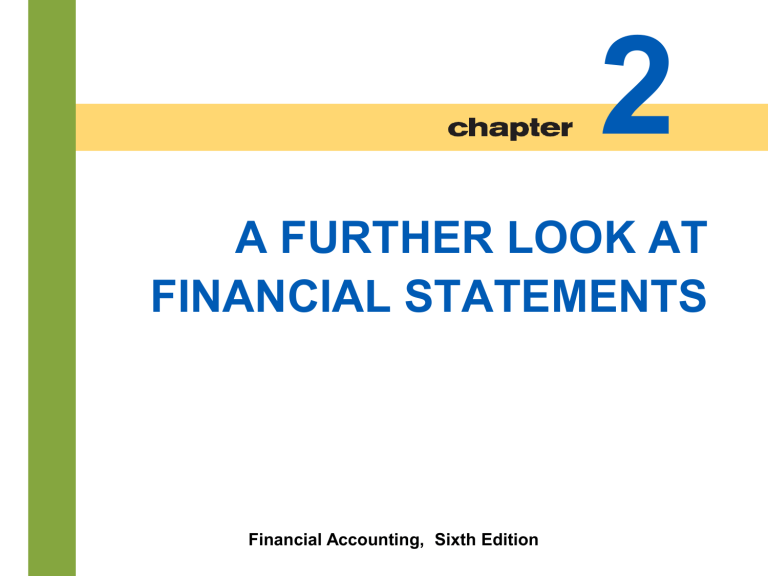
2
A FURTHER LOOK AT
FINANCIAL STATEMENTS
2-1
Financial Accounting, Sixth Edition
Study Objectives
2-2
1.
Identify the sections of a classified balance sheet.
2.
Identify and compute ratios for analyzing a company’s profitability.
3.
Explain the relationship between a retained earnings statement and a statement of stockholders’ equity.
4.
Identify and compute ratios for analyzing a company’s liquidity and solvency using a balance sheet.
5.
Use the statement of cash flows to evaluate solvency.
6.
Explain the meaning of generally accepted accounting principles.
7.
Discuss financial reporting concepts.
2-3
The Classified Balance Sheet
Presents a snapshot at a point in time .
To improve understanding, companies group similar assets and similar liabilities together.
Standard Classifications
Illustration 2-1
SO 1 Identify the sections of a classified balance sheet.
2-4
The Classified Balance Sheet
Illustration 2-2
SO 1
2-5
The Classified Balance Sheet
Illustration 2-2
SO 1
2-6
The Classified Balance Sheet
Current Assets
Assets that a company expects to convert to cash or use up within one year or the operating cycle , whichever is longer .
Operating cycle is the average time it takes from the purchase of inventory to the collection of cash from customers.
SO 1 Identify the sections of a classified balance sheet.
The Classified Balance Sheet
Current Assets
Illustration 2-3
2-7
Companies list current asset accounts in the order they expect to convert them into cash.
SO 1 Identify the sections of a classified balance sheet.
2-8
The Classified Balance Sheet
Long-Term Investments
Investments in stocks and bonds of other companies that are held for more than one year.
Investments in long-term assets such as land or buildings not currently being used in operating activities.
Illustration 2-4
SO 1 Identify the sections of a classified balance sheet.
2-9
The Classified Balance Sheet
Property, Plant, and Equipment
Long useful lives .
Currently used in operations.
Depreciation - allocating the cost of assets to a number of years.
Accumulated depreciation - total amount of depreciation expensed thus far in the asset’s life.
SO 1 Identify the sections of a classified balance sheet.
The Classified Balance Sheet
Property, Plant, and Equipment
Illustration 2-5
2-10 SO 1 Identify the sections of a classified balance sheet.
The Classified Balance Sheet
Intangible Assets
Assets that do not have physical substance.
Illustration 2-6
2-11 SO 1 Identify the sections of a classified balance sheet.
2-12
The Classified Balance Sheet
Current Liabilities
Obligations the company is to pay within the coming year.
Usually list notes payable first, followed by accounts payable.
Other items follow in order of magnitude.
Liquidity – ability to pay obligations expected to be due within the next year.
SO 1 Identify the sections of a classified balance sheet.
The Classified Balance Sheet
Current Liabilities
Illustration 2-7
2-13 SO 1 Identify the sections of a classified balance sheet.
The Classified Balance Sheet
Long-Term Liabilities
Obligations a company expects to pay after one year.
Illustration 2-8
2-14 SO 1 Identify the sections of a classified balance sheet.
The Classified Balance Sheet
Stockholders’ Equity
Illustration 2-2
2-15
Common stock - investments of assets into the business by the stockholders.
Retained earnings - income retained for use in the business.
SO 1 Identify the sections of a classified balance sheet.
2-16
Using the Financial Statements
Ratio Analysis
Ratio analysis expresses the relationship among selected items of financial statement data.
A ratio expresses the mathematical relationship between one quantity and another.
2-17
Using the Financial Statements
Using the Financial Statements
Using the Income Statement
Illustration 2-10
Profitability ratios measure the operating success of a company for a given period of time.
2-18 SO 2 Identify and compute ratios for analyzing a company’s profitability.
2-19
Using the Financial Statements
Profitability
Ratio
Illustration: Earnings per share (EPS) measures the net income earned on each share of common stock.
Best Buy
Illustration 2-11
$1,003 - $0
(414 + 411) 2
=
$2.43
$1,407
(411
- $0
+ 481) 2
=
$3.15
Using the Financial Statements
Using the Statement of Stockholders’ Equity
Illustration 2-12
Most companies use a statement of stockholders’ equity , rather than a retained earnings statement , so that they can report all changes in stockholders’ equity accounts.
2-20
SO 3 Explain the relationship between a retained earnings statement and a statement of stockholders’ equity.
2-21
Using the Financial Statements
Using the Statement of Stockholders’ Equity
Observations from this financial statement of Best Buy :
► Common stock decreased during the first year because the stock issuance was much smaller than the stock repurchase.
► Common stock increased in the second year as the result of an issuance of shares..
► Best Buy paid dividends each year.
► Prior to 2003 , Best Buy did not pay dividends, even though it was profitable and could do so.
Why didn’t Best Buy pay dividends prior to 2003?
SO 3 Explain the relationship between a retained earnings statement and a statement of stockholders’ equity.
2-22
Using the
Financial
Statements
Using a
Classified
Balance Sheet
Illustration 2-13
Using the Financial Statements
Using a Classified Balance Sheet
Liquidity —the ability to pay obligations expected to become due within the next year or operating cycle.
Illustration 2-14
2-23
When working capital is positive, there is greater likelihood that the company will pay its liabilities.
Best Buy had a NEGATIVE working capital in 2009 of $243 million.
SO 4 Identify and compute ratios for analyzing a company’s liquidity and solvency using a balance sheet.
Using the Financial Statements
Liquidity
Ratio
Liquidity ratios measure the short-term ability to pay maturing obligations and to meet unexpected needs for cash.
Illustration 2-15
2-24
For every dollar of current liabilities, Best Buy has $.97 of current assets
SO 4 Identify and compute ratios for analyzing a company’s liquidity and solvency using a balance sheet.
Using the Financial Statements
Using a Classified Balance Sheet
Solvency —the ability to pay interest as it comes due and to repay the balance of a debt due at its maturity.
Solvency ratios measure the ability of the company to survive over a long period of time.
2-25
SO 4 Identify and compute ratios for analyzing a company’s liquidity and solvency using a balance sheet.
Using the Financial Statements
Solvency
Ratio
Debt to total assets ratio measures the percentage of total financing provided by creditors rather than stockholders.
Illustration 2-16
The 2009 ratio means that every dollar of assets was financed by 71 cents of debt.
2-26
SO 4 Identify and compute ratios for analyzing a company’s liquidity and solvency using a balance sheet.
Financial Reports Concepts
2-27
The Standard-Setting Environment
Generally Accepted Accounting Principles (GAAP) A set of rules and practices, having substantial authoritative support, that the accounting profession recognizes as a general guide for financial reporting purposes.
Standard-setting bodies determine these guidelines:
► Securities and Exchange Commission (SEC)
►
►
Financial Accounting Standards Board (FASB)
International Accounting Standards Board (IASB)
► Public Company Accounting Oversight Board (PCAOB)
SO 6 Explain the meaning of generally accepted accounting principles.
2-28
Financial Reports Concepts
Qualities of Useful Information
According to the FASB , useful information should possess two fundamental qualities, relevance and faithful representation .
Illustration 2-17
SO 7
Financial Reports Concepts
Qualities of Useful Information
Enhancing Qualities
2-29
Comparability results when different companies use the same accounting principles.
Information is verifiable able to prove that it is free from error.
Consistency means that a company uses the same accounting principles and methods from year to year.
if we are
Information has the quality of understandability if it is presented in a clear and concise fashion.
For accounting information to be relevant, it must be timely .
SO 7 Discuss financial reporting concepts.
Financial Reports Concepts
Assumptions in Financial Reporting
Economic Entity
States that every economic entity can be separately identified and accounted for.
2-30
Monetary Unit
Requires that only those things that can be expressed in money are included in the accounting records.
Illustration 2-18
Periodicity
States that the life of a business can be divided into artificial time periods.
SO 7 Discuss financial reporting concepts.
Financial Reports Concepts
Assumptions in Financial Reporting
Illustration 2-18
2-31
Going Concern
The business will remain in operation for the foreseeable future.
Accrual-Basis
Transactions are recorded in the periods in which the events occur.
SO 7 Discuss financial reporting concepts.
Financial Reports Concepts
2-32
Principles in Financial Reporting
Measurement Principles
Cost
Or historical cost principle, dictates that companies record assets at their cost.
Fair Value
Indicates that assets and liabilities should be reported at fair value (the price received to sell an asset or settle a liability).
Full disclosure
Requires that companies disclose all circumstances and events that would make a difference to financial statement users.
SO 7 Discuss financial reporting concepts.
2-33
Financial Reports Concepts
Constraints in Financial Reporting
Illustration 2-19
Materiality Constraint
An item is material when its size makes it likely to influence the decision of an investor or creditor.
Cost Constraint
Accounting standard-setters weigh the cost that companies will incur to provide the information against the benefit that financial statement users will gain.
SO 7
